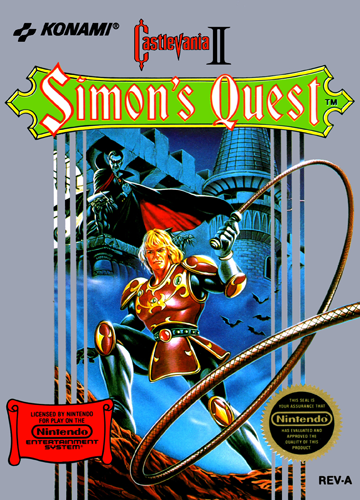

Castlevania II: Simon's Quest for the NES is a highly anticipated sequel to the original Castlevania game. Developed and published by Konami in 1987, it introduced several innovative gameplay elements and expanded the world of Castlevania. While its ambition is commendable, this title is not without its flaws. Join me as we delve into the depths of Dracula's domain and uncover the strengths and weaknesses of Castlevania II: Simon's Quest.
Year: 1988
Manufacturer: Konami
Genre: Platform
Rating: HSRS - GA (General Audience)
Gameplay:
Unlike its predecessor, Castlevania II: Simon's Quest takes a departure from the traditional linear platforming action and embraces a more open-world, exploration-focused approach. Players control Simon Belmont as he embarks on a quest to collect Dracula's body parts and resurrect him in order to rid the curse that afflicts him.
The nonlinear gameplay was a refreshing change at the time, allowing players to freely explore the interconnected Transylvanian towns and mansions. The addition of RPG-like elements, such as experience points, leveling up, and purchasing items from villagers, added depth to the game's progression. However, the lack of clear direction and cryptic clues often led to frustrating and confusing moments, leaving players wandering aimlessly or resorting to trial-and-error methods.
Combat mechanics remain similar to the first game, with Simon utilizing his whip and a variety of secondary weapons to fend off the undead and other monstrosities. Unfortunately, the controls feel sluggish and imprecise, making combat encounters more challenging than necessary. Additionally, the game suffers from questionable hit detection, resulting in frustrating moments where attacks miss their mark or cause unintended damage.
Visuals and Sound:
Considering the NES hardware limitations, Castlevania II: Simon's Quest features detailed and atmospheric visuals. The gothic-inspired environments, ranging from eerie forests to haunted mansions, effectively create an ominous and foreboding atmosphere. However, the game's color palette can feel somewhat limited, and the sprite flickering and occasional slowdowns can hinder the overall visual experience.
The game's soundtrack is a mixed bag. While some tracks, such as the iconic "Bloody Tears," are memorable and perfectly suited for the game's setting, others lack variety and can become repetitive over time. The sound effects, though limited in range, effectively enhance the spooky ambiance and contribute to the overall immersion.
Story and Narrative:
Castlevania II: Simon's Quest expands upon the lore of the series, giving players a deeper insight into Simon Belmont's personal journey. The premise of collecting Dracula's body parts to break the curse is intriguing, and the occasional encounters with non-playable characters provide snippets of lore and valuable information. However, the game's translation is notably flawed, leading to cryptic and often nonsensical dialogue that can further confuse players. Improved localization could have significantly enhanced the narrative experience.

Conclusion:
Castlevania II: Simon's Quest is an ambitious and daring departure from its predecessor, attempting to bring exploration and RPG elements to the Castlevania series. While it successfully created a foreboding atmosphere and expanded the lore, it suffered from gameplay frustrations, imprecise controls, and a lack of clear direction. Despite its flaws, the game remains a notable entry in the Castlevania franchise, paving the way for future iterations to build upon its ideas. If you're a fan of the series or enjoy retro gaming challenges, Castlevania II: Simon's Quest is worth a play, but be prepared for a journey that is equal parts captivating and frustrating.
Explore in-depth reviews and analyses of classic Nintendo Entertainment System (NES) games, including gameplay mechanics, graphics, sound, and overall nostalgic experience.